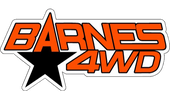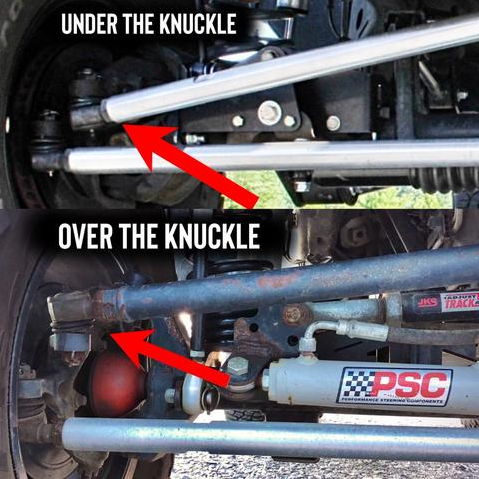So you're thinking of going to over the knuckle steering? Over the knuckle steering or "OTK" steering is a good option for a lot of people. But for others, it could potentially limit your vehicles potential. Let's take a look at the benefits and drawbacks of OTK steering. This blog will pertain to our steering kits.
1) Steering Components Explained
We're going to start with the real basics here because let's face it, you used to be a beginner too. The first thing we need to know is what we're talking about when we mention key parts in the steering system. Pictured above is a tie rod and drag link. These two links are the key components used in a crossover steering set up like the ones found on JK's and JL's. The tie rod is attached to a knuckle on the drivers side and the passengers side. This keeps both wheels pointed in the same direction once the vehicle has been aligned. The next part of this system is the drag link. This link is connected to your passenger side knuckle, and then to your pitman arm. Your pitman arm is connected to your steering box which eventually is connected to your steering wheel. Movement of the steering wheel will turn your pitman arm to move your drag link either to the passenger or driver side. When used together, the drag link pushes the passenger side knuckle, which the tie rod is also attached to, then the tie rod pushes the drivers side knuckle. This results in both of your wheels turning in the same direction.
2) So What Is Over The Knuckle Steering?
Now that we have an understanding of steering linkages, let's dive into what OTK steering actually is.
Pictured above you see the two types of drag links. Under the knuckle, and over the knuckle. The under the knuckle set up is how JK's & JL's come from the factory. They are literally mounted on the underside of the passenger side knuckle, hence the term "under the knuckle". The over the knuckle set up pictured on the bottom is the same idea, but mounted on the top side of the knuckle, hence the term "over the knuckle". Jeeps do not come this way from the factory and if you see a set up like this, you know it is aftermarket. Now that we know the difference between the two, let's dive into the pros and cons of both of them.
3) Pros & Cons of UTK & OTK Steering
The pros of under the knuckle steering are pretty standard, yet effective. For one, when your drag link is mounted under the knuckle it will steer clear of the frame rail on a JK/JL. This allows your vehicle to have more flex due to the fact that you do not have to set your bump stops to accommodate for the frame. Another benefit is the install. You literally just need a ratchet to install our UTK drag link. No drilling is required and you can have it installed in around 20-30mins.
The cons of under the knuckle steering are geometry and room for accessories. You see, when you lift a JK 3.5" or more you start to really steepen the angle of your drag link. This is not good for a few reasons. One, the steeper the drag link, the less responsive the steering will feel. Two, most lift kit companies include a lifted track bar bracket with lift kits that are 3.5" or more. When you do that, your track bar will be more horizontal than your drag link if it is still under the knuckle. The golden rule is that you want your drag link and track bar to be as close to the same angle as possible. Pictured below.
Another con is that most UTK set ups don't have room to accommodate a hydro assist ram and some steering stabilizers in the stock position. Some people make it work by welding some tabs to their diff cover and running it off of that but most don't want to do the extra work and just want it to be mounted in the stock position. Note: most steering stabilizers will work with UTK steering, there are a select few that do not. Mainly the unique through shaft designs like the teraflex nexus and some others.
Now let's see the pros and cons of OTK steering.
The pros of over the knuckle steering are geometry and room for hydro assist/some steering stabilizers. For some reason the world thinks that a OTK drag link will give you "more ground clearance". Which is just simply not true. Your tie rod is still hanging lower than the drag link so that is not the case. If you've lifted your jeep more than 3.5" or more we recommend to start looking into going OTK. Again, this is because most lift kits come with a raised track bar bracket once you get to that height, and if you have raised where your track bar mounts, you need to raise where your drag link mounts as well. Another benefit is that most under the knuckle set ups do not allow you to mount a hydro assist ram in the factory location. Once you move the mounting location of your drag link to over the knuckle, this allows you to run a hydro assist ram much easier.
The cons of over the knuckle steering are clearance and honestly just mis-information. The entire jeep world has gone stir crazy about OTK steering and thinks that it is an upgrade no matter how your jeep is set up. However it can actually hurt more than help if your jeep is not built to have it. If you're running less than 3.5" we recommend really thinking about whether or not you need it. The reason behind this is because your drag link will hit your frame if you do not extend your bump-stops. Pictured below.
Which sounds like it's not a big deal, and to some it's not. However most people don't want to spend all that money on 3" of lift and then have to limit their flex due to their over the knuckle drag link. The only other way around it (if you don't want to extend your bump-stops) is to notch your frame, which scares the begeezus out of most people. Again, you can run this with less than a 3.5" lift, but be prepared to lose some flex. These are most of the cons you're going to run into with OTK steering.
DISCLAIMER:
All of the information you have read in this blog post is spoken in the general sense. Some people have very unique builds that require a little more calculation that just a general "is it lifted 3.5"? That being said, this blog was made to inform you about what you should think about before pulling the trigger on either kind of steering set up. Read through it, figure out what you want out of your rig, and then make a educated decision. Purchasing the wrong kit can limit your rig's potential and we don't want that for you.
So we hope that helps your decision, if you have any extra questions we didn't cover, feel free to give us a call or shoot us an email.
Click the link below to go to our Aluminum Steering Product Page.
Email: Sales@barnes4wd.com
Phone: 828-551-7616





